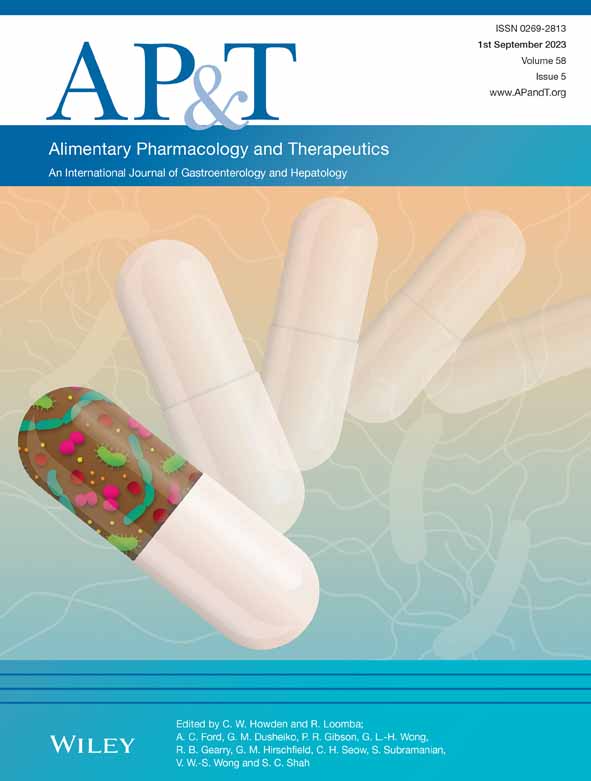Editorial: One step closer to personalised nutrition therapy for irritable bowel syndrome
LINKED CONTENT
This article is linked to Wilson et al paper. To view this article, visit https://doi.org/10.1111/apt.17609
The Low FODMAP diet (LFD) has become a mainstay in the management of irritable bowel syndrome (IBS) due to its high rates of symptom improvement. However, it is onerous and at least 30% of patients who follow the diet do not respond.1 The ability to predict and select those who are most likely to respond would be of great benefit in clinical practice and potentially avoid trialling a taxing diet.
Past candidates for predictors of dietary response to a LFD have fallen short, despite their valid hypothesis. To date, data around microbiota in IBS predicting LFD response have been conflicting, both before and following FODMAP restriction; one study even challenged the idea that a LFD is detrimental to colonic microbiota.2 Emerging data have indicated that the metabolites of microbiota, rather than the microbiota themselves, may prove to be the signal to determine dietary management. Wilson et al have identified that faecal metabolites, but not microbiota, predicted response to a LFD in addition to a new metabolite medium in urine.3 This is a welcomed addition to the existing literature and may indicate that we are one step closer to personalised nutrition therapy for IBS.
One metabolite extensively evaluated to identify responders to a LFD is breath hydrogen. The idea that this marker would identify specific carbohydrate delivery to the colon and predict dietary response, but has been futile, thought due to the poor test reproducibility and the irrelevant clinical utility of providing supraphysiological doses of pure FODMAP solutions.4, 5 Indeed, trial evidence has shown that large doses of completely unabsorbed FODMAPs (e.g., lactulose) do not predict dietary response.6 It may be that other colonic metabolites have potential to predict response to a LFD.
While Wilson et al showed the metabolite faecal propionate as a predictor, the data for faecal short chain fatty acids in relation to FODMAP ingestion are inconsistent, perhaps as stool only represents 5% of colonic SCFA.7 However, faecal volatile organic compounds (VOC) have already shown promise to predict LFD response in 97% of IBS patients in one study.8 The lower urinary creatinine and higher TMAO (trymethylamine N-oxide) at baseline in responders could represent a lower muscle mass and higher meat intake, respectively, but baseline protein, as a surrogate marker of meat intake, did not differ between groups. One dietary measure lacking in this study was diet quality, which is a possible confounder as a LFD can improve diet quality, also leading to symptomatic improvement.9 This is supported by the finding that responders had higher urinary citrate (associated with fruit and vegetable intake) after the LFD. However, urinary hippurate was conflicting this idea. Detailed dietary analysis, including markers of diet quality, would aid in identifying dietary confounders.
For clinicians, accessible and affordable tests that are able to be interpreted to guide response to a LFD are desirable. The data from this study show the potential for VOC to predict response. Their application in trials of well-controlled diets and considerations of dietary confounders is much awaited.
AUTHOR CONTRIBUTIONS
Sarah L Melton: Conceptualization (equal); data curation (equal); writing – original draft (equal); writing – review and editing (equal). Emma P Halmos: Conceptualization (equal); data curation (equal); writing – original draft (equal); writing – review and editing (equal).
ACKNOWLEDGEMENTS
Declaration of personal interests: SLM: no conflicts; EPH: Speaker for Sandoz Pty Ltd. She has received research grants for investigator-driven studies from Mindset Health Pty Ltd.
FUNDING INFORMATION
SLM is in receipt of a Monash University Research Training Programme and Crohn's Colitis Australia Scholarships; EPH has an Investigator Grant from the National Health and Medical Research Council of Australia.
LINKED CONTENT
This article is linked to Wilson et al paper. To view this article, visit https://doi.org/10.1111/apt.17609




